Collaborative Practice in Case Management of Healthcare Systems Report
VerifiedAdded on 2023/06/04
|7
|1535
|498
Report
AI Summary
This report provides an executive summary on collaborative practice in case management within healthcare systems. It emphasizes the importance of collaboration among case managers, providers, payers, and family members to achieve positive patient outcomes. The report discusses the role of case management, highlighting the need for improved outcomes through technology and better clinical standards. It presents examples of successful collaborations, such as reducing hospitalizations and healthcare costs. Challenges in the healthcare system are also addressed, including health reforms, eligibility standards, and the need for strong community-based organizations. The conclusion reinforces the benefits of collaborative practice, including improved care coordination, patient empowerment, and increased provider satisfaction. References to relevant studies are included.
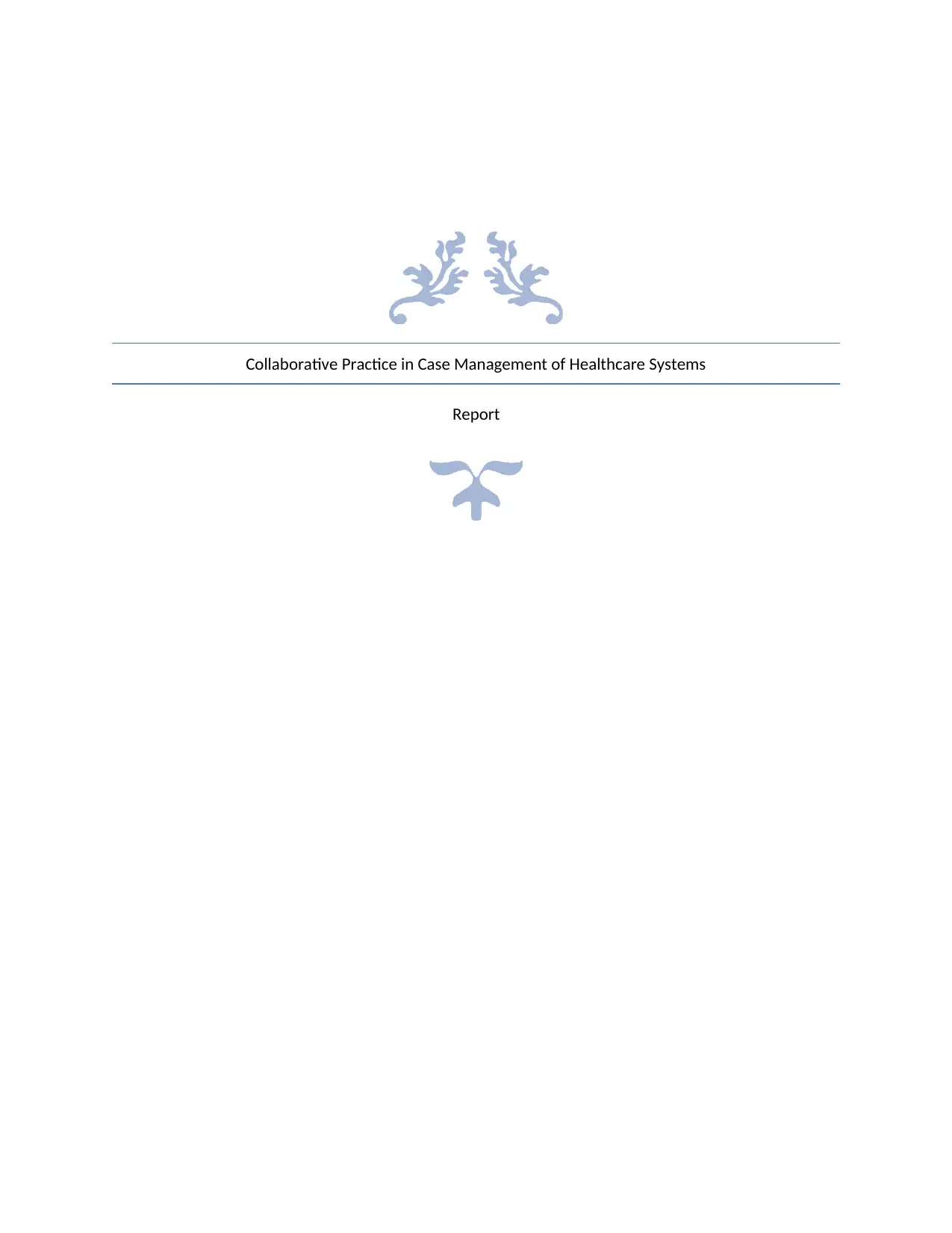
Collaborative Practice in Case Management of Healthcare Systems
Report
Report
Paraphrase This Document
Need a fresh take? Get an instant paraphrase of this document with our AI Paraphraser
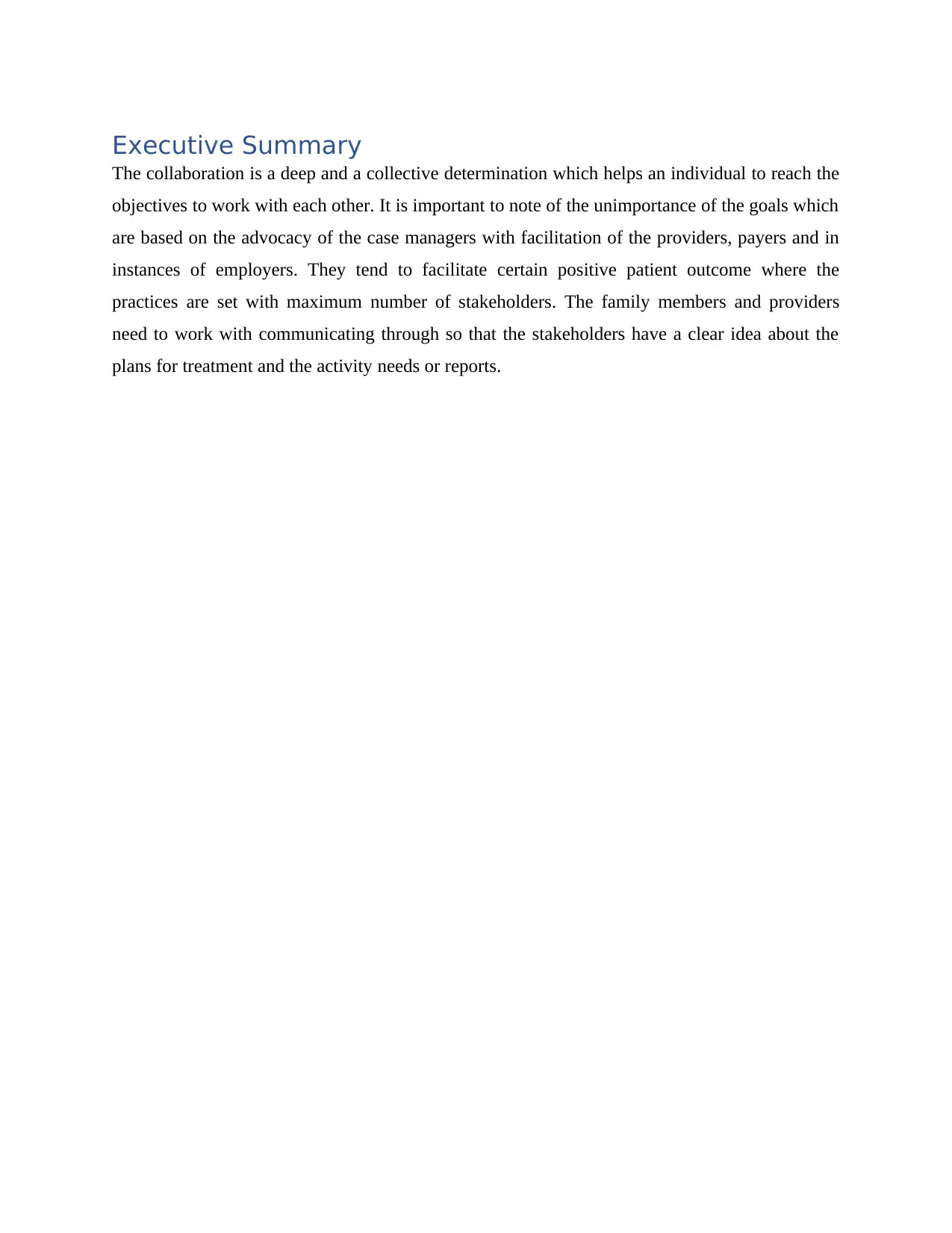
Executive Summary
The collaboration is a deep and a collective determination which helps an individual to reach the
objectives to work with each other. It is important to note of the unimportance of the goals which
are based on the advocacy of the case managers with facilitation of the providers, payers and in
instances of employers. They tend to facilitate certain positive patient outcome where the
practices are set with maximum number of stakeholders. The family members and providers
need to work with communicating through so that the stakeholders have a clear idea about the
plans for treatment and the activity needs or reports.
The collaboration is a deep and a collective determination which helps an individual to reach the
objectives to work with each other. It is important to note of the unimportance of the goals which
are based on the advocacy of the case managers with facilitation of the providers, payers and in
instances of employers. They tend to facilitate certain positive patient outcome where the
practices are set with maximum number of stakeholders. The family members and providers
need to work with communicating through so that the stakeholders have a clear idea about the
plans for treatment and the activity needs or reports.

Contents
Introduction......................................................................................................................................1
Discussion of the role......................................................................................................................1
Example of successful collaboration...............................................................................................1
Challenges to overcome...................................................................................................................2
Conclusion.......................................................................................................................................3
References........................................................................................................................................3
Introduction......................................................................................................................................1
Discussion of the role......................................................................................................................1
Example of successful collaboration...............................................................................................1
Challenges to overcome...................................................................................................................2
Conclusion.......................................................................................................................................3
References........................................................................................................................................3
⊘ This is a preview!⊘
Do you want full access?
Subscribe today to unlock all pages.

Trusted by 1+ million students worldwide
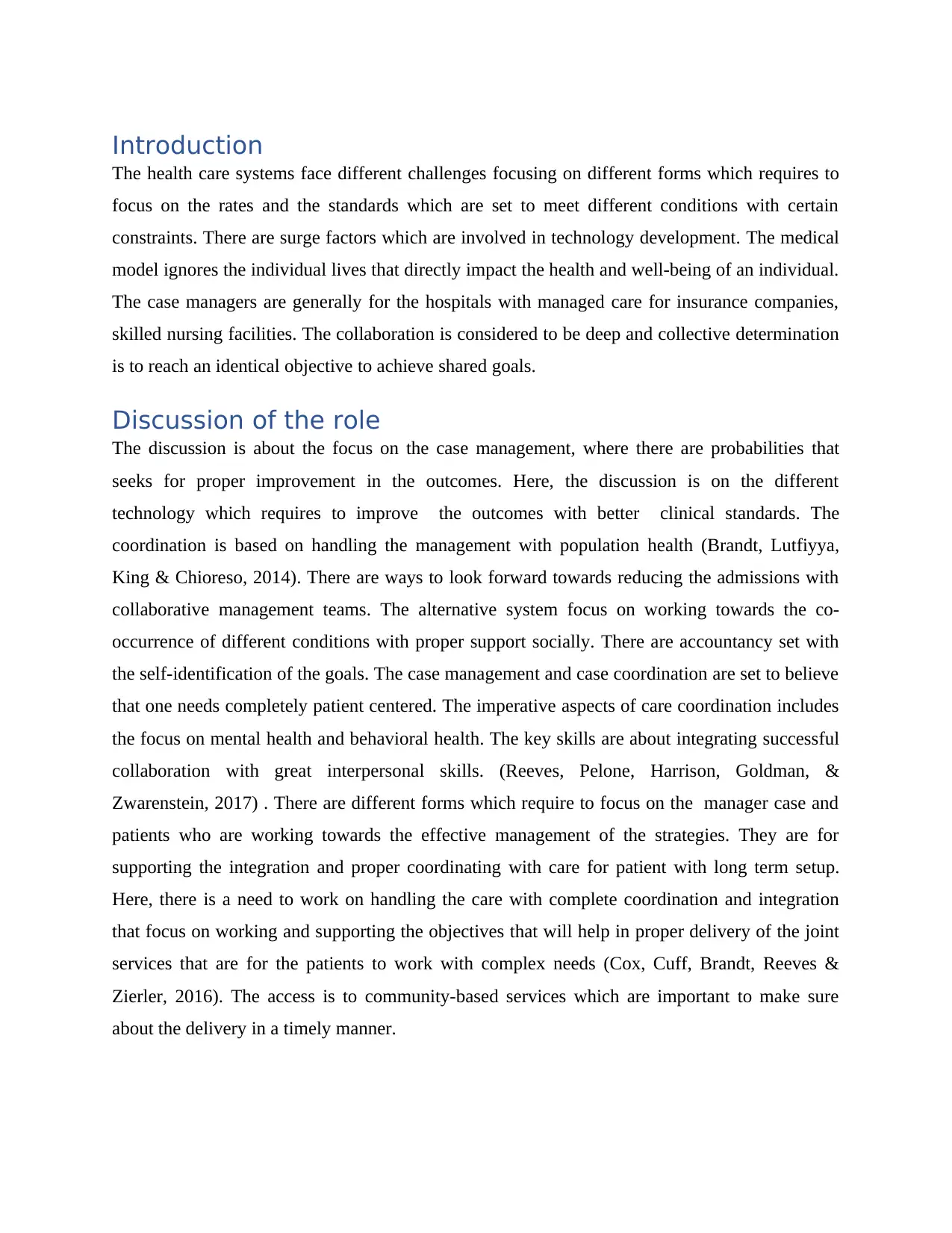
Introduction
The health care systems face different challenges focusing on different forms which requires to
focus on the rates and the standards which are set to meet different conditions with certain
constraints. There are surge factors which are involved in technology development. The medical
model ignores the individual lives that directly impact the health and well-being of an individual.
The case managers are generally for the hospitals with managed care for insurance companies,
skilled nursing facilities. The collaboration is considered to be deep and collective determination
is to reach an identical objective to achieve shared goals.
Discussion of the role
The discussion is about the focus on the case management, where there are probabilities that
seeks for proper improvement in the outcomes. Here, the discussion is on the different
technology which requires to improve the outcomes with better clinical standards. The
coordination is based on handling the management with population health (Brandt, Lutfiyya,
King & Chioreso, 2014). There are ways to look forward towards reducing the admissions with
collaborative management teams. The alternative system focus on working towards the co-
occurrence of different conditions with proper support socially. There are accountancy set with
the self-identification of the goals. The case management and case coordination are set to believe
that one needs completely patient centered. The imperative aspects of care coordination includes
the focus on mental health and behavioral health. The key skills are about integrating successful
collaboration with great interpersonal skills. (Reeves, Pelone, Harrison, Goldman, &
Zwarenstein, 2017) . There are different forms which require to focus on the manager case and
patients who are working towards the effective management of the strategies. They are for
supporting the integration and proper coordinating with care for patient with long term setup.
Here, there is a need to work on handling the care with complete coordination and integration
that focus on working and supporting the objectives that will help in proper delivery of the joint
services that are for the patients to work with complex needs (Cox, Cuff, Brandt, Reeves &
Zierler, 2016). The access is to community-based services which are important to make sure
about the delivery in a timely manner.
The health care systems face different challenges focusing on different forms which requires to
focus on the rates and the standards which are set to meet different conditions with certain
constraints. There are surge factors which are involved in technology development. The medical
model ignores the individual lives that directly impact the health and well-being of an individual.
The case managers are generally for the hospitals with managed care for insurance companies,
skilled nursing facilities. The collaboration is considered to be deep and collective determination
is to reach an identical objective to achieve shared goals.
Discussion of the role
The discussion is about the focus on the case management, where there are probabilities that
seeks for proper improvement in the outcomes. Here, the discussion is on the different
technology which requires to improve the outcomes with better clinical standards. The
coordination is based on handling the management with population health (Brandt, Lutfiyya,
King & Chioreso, 2014). There are ways to look forward towards reducing the admissions with
collaborative management teams. The alternative system focus on working towards the co-
occurrence of different conditions with proper support socially. There are accountancy set with
the self-identification of the goals. The case management and case coordination are set to believe
that one needs completely patient centered. The imperative aspects of care coordination includes
the focus on mental health and behavioral health. The key skills are about integrating successful
collaboration with great interpersonal skills. (Reeves, Pelone, Harrison, Goldman, &
Zwarenstein, 2017) . There are different forms which require to focus on the manager case and
patients who are working towards the effective management of the strategies. They are for
supporting the integration and proper coordinating with care for patient with long term setup.
Here, there is a need to work on handling the care with complete coordination and integration
that focus on working and supporting the objectives that will help in proper delivery of the joint
services that are for the patients to work with complex needs (Cox, Cuff, Brandt, Reeves &
Zierler, 2016). The access is to community-based services which are important to make sure
about the delivery in a timely manner.
Paraphrase This Document
Need a fresh take? Get an instant paraphrase of this document with our AI Paraphraser
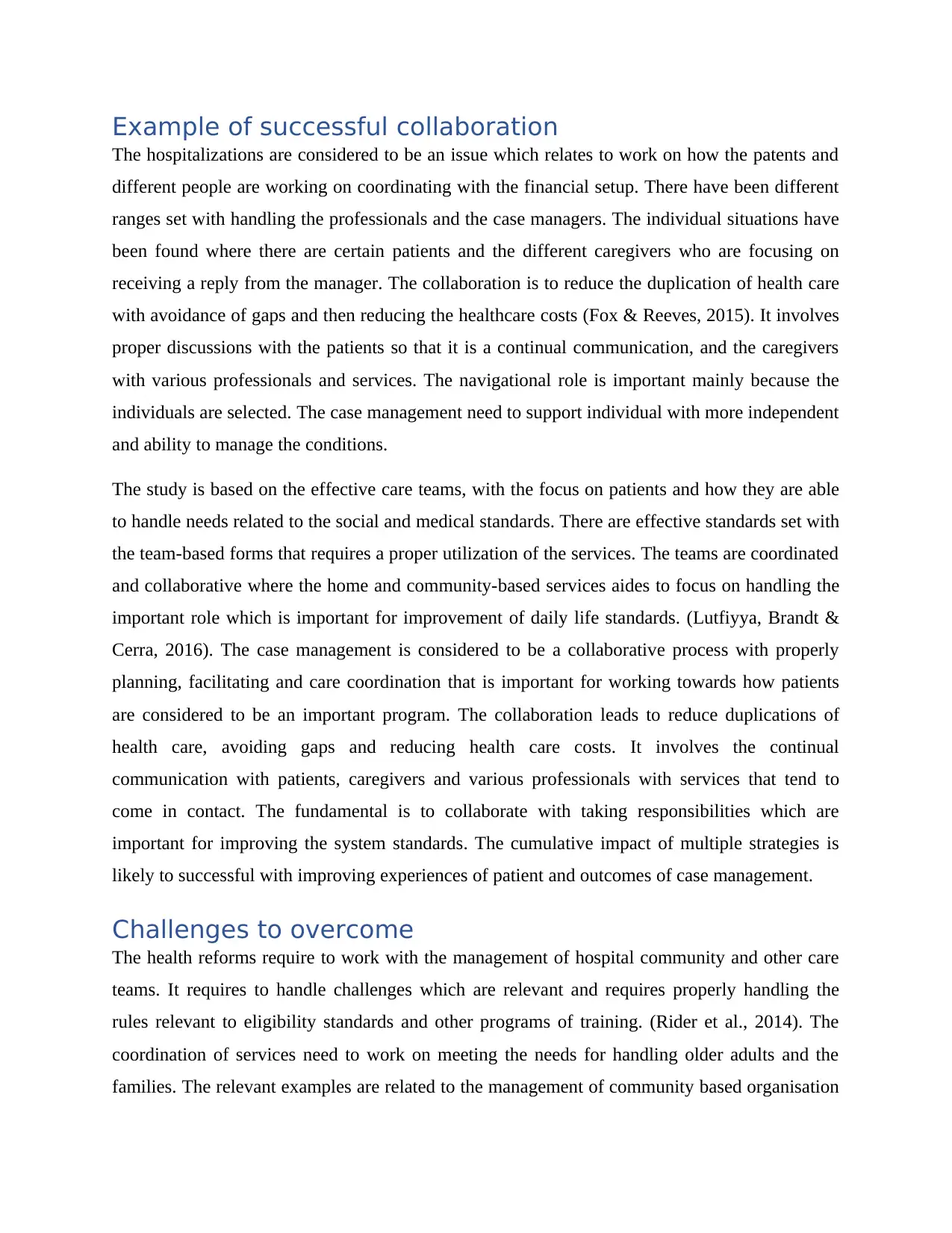
Example of successful collaboration
The hospitalizations are considered to be an issue which relates to work on how the patents and
different people are working on coordinating with the financial setup. There have been different
ranges set with handling the professionals and the case managers. The individual situations have
been found where there are certain patients and the different caregivers who are focusing on
receiving a reply from the manager. The collaboration is to reduce the duplication of health care
with avoidance of gaps and then reducing the healthcare costs (Fox & Reeves, 2015). It involves
proper discussions with the patients so that it is a continual communication, and the caregivers
with various professionals and services. The navigational role is important mainly because the
individuals are selected. The case management need to support individual with more independent
and ability to manage the conditions.
The study is based on the effective care teams, with the focus on patients and how they are able
to handle needs related to the social and medical standards. There are effective standards set with
the team-based forms that requires a proper utilization of the services. The teams are coordinated
and collaborative where the home and community-based services aides to focus on handling the
important role which is important for improvement of daily life standards. (Lutfiyya, Brandt &
Cerra, 2016). The case management is considered to be a collaborative process with properly
planning, facilitating and care coordination that is important for working towards how patients
are considered to be an important program. The collaboration leads to reduce duplications of
health care, avoiding gaps and reducing health care costs. It involves the continual
communication with patients, caregivers and various professionals with services that tend to
come in contact. The fundamental is to collaborate with taking responsibilities which are
important for improving the system standards. The cumulative impact of multiple strategies is
likely to successful with improving experiences of patient and outcomes of case management.
Challenges to overcome
The health reforms require to work with the management of hospital community and other care
teams. It requires to handle challenges which are relevant and requires properly handling the
rules relevant to eligibility standards and other programs of training. (Rider et al., 2014). The
coordination of services need to work on meeting the needs for handling older adults and the
families. The relevant examples are related to the management of community based organisation
The hospitalizations are considered to be an issue which relates to work on how the patents and
different people are working on coordinating with the financial setup. There have been different
ranges set with handling the professionals and the case managers. The individual situations have
been found where there are certain patients and the different caregivers who are focusing on
receiving a reply from the manager. The collaboration is to reduce the duplication of health care
with avoidance of gaps and then reducing the healthcare costs (Fox & Reeves, 2015). It involves
proper discussions with the patients so that it is a continual communication, and the caregivers
with various professionals and services. The navigational role is important mainly because the
individuals are selected. The case management need to support individual with more independent
and ability to manage the conditions.
The study is based on the effective care teams, with the focus on patients and how they are able
to handle needs related to the social and medical standards. There are effective standards set with
the team-based forms that requires a proper utilization of the services. The teams are coordinated
and collaborative where the home and community-based services aides to focus on handling the
important role which is important for improvement of daily life standards. (Lutfiyya, Brandt &
Cerra, 2016). The case management is considered to be a collaborative process with properly
planning, facilitating and care coordination that is important for working towards how patients
are considered to be an important program. The collaboration leads to reduce duplications of
health care, avoiding gaps and reducing health care costs. It involves the continual
communication with patients, caregivers and various professionals with services that tend to
come in contact. The fundamental is to collaborate with taking responsibilities which are
important for improving the system standards. The cumulative impact of multiple strategies is
likely to successful with improving experiences of patient and outcomes of case management.
Challenges to overcome
The health reforms require to work with the management of hospital community and other care
teams. It requires to handle challenges which are relevant and requires properly handling the
rules relevant to eligibility standards and other programs of training. (Rider et al., 2014). The
coordination of services need to work on meeting the needs for handling older adults and the
families. The relevant examples are related to the management of community based organisation
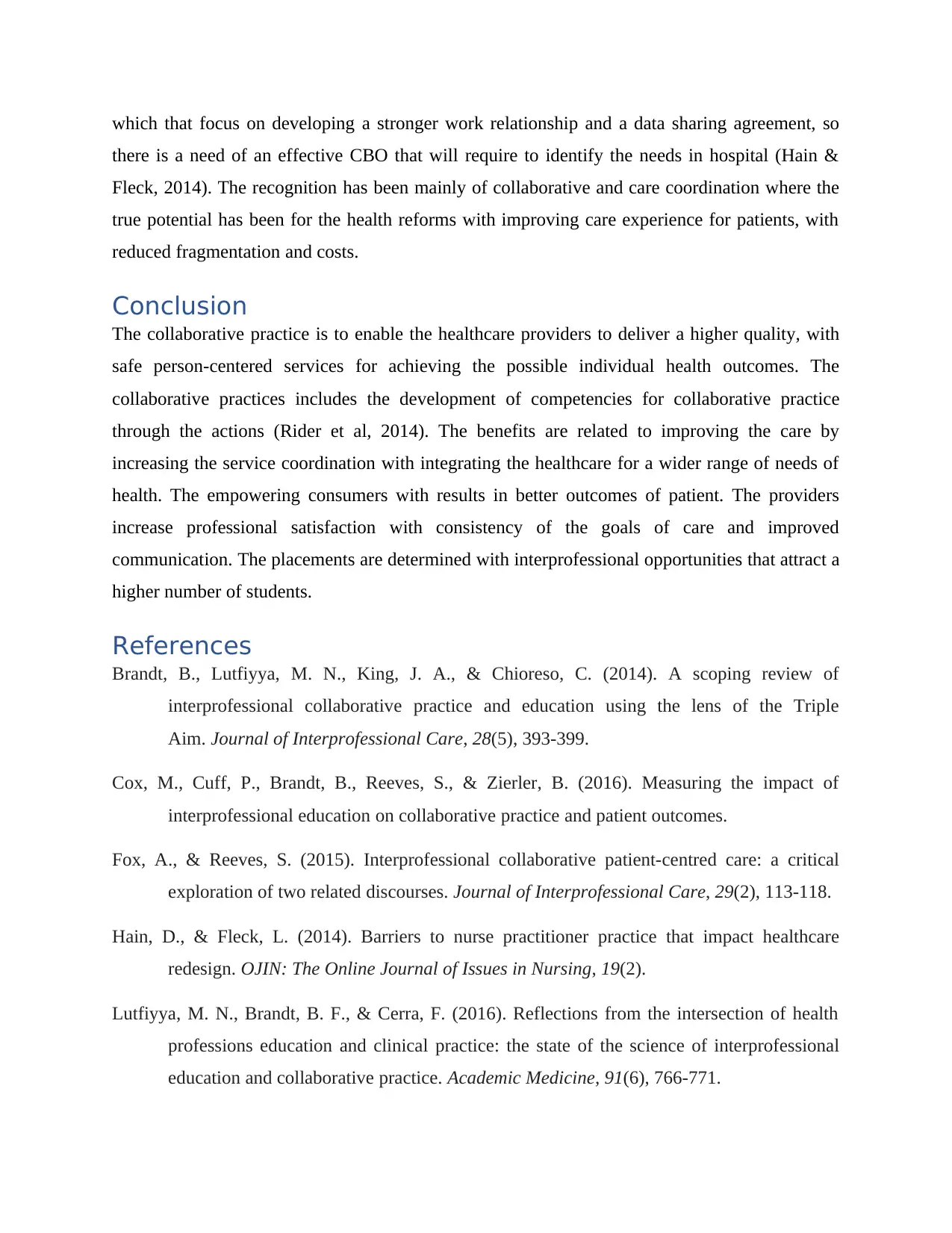
which that focus on developing a stronger work relationship and a data sharing agreement, so
there is a need of an effective CBO that will require to identify the needs in hospital (Hain &
Fleck, 2014). The recognition has been mainly of collaborative and care coordination where the
true potential has been for the health reforms with improving care experience for patients, with
reduced fragmentation and costs.
Conclusion
The collaborative practice is to enable the healthcare providers to deliver a higher quality, with
safe person-centered services for achieving the possible individual health outcomes. The
collaborative practices includes the development of competencies for collaborative practice
through the actions (Rider et al, 2014). The benefits are related to improving the care by
increasing the service coordination with integrating the healthcare for a wider range of needs of
health. The empowering consumers with results in better outcomes of patient. The providers
increase professional satisfaction with consistency of the goals of care and improved
communication. The placements are determined with interprofessional opportunities that attract a
higher number of students.
References
Brandt, B., Lutfiyya, M. N., King, J. A., & Chioreso, C. (2014). A scoping review of
interprofessional collaborative practice and education using the lens of the Triple
Aim. Journal of Interprofessional Care, 28(5), 393-399.
Cox, M., Cuff, P., Brandt, B., Reeves, S., & Zierler, B. (2016). Measuring the impact of
interprofessional education on collaborative practice and patient outcomes.
Fox, A., & Reeves, S. (2015). Interprofessional collaborative patient-centred care: a critical
exploration of two related discourses. Journal of Interprofessional Care, 29(2), 113-118.
Hain, D., & Fleck, L. (2014). Barriers to nurse practitioner practice that impact healthcare
redesign. OJIN: The Online Journal of Issues in Nursing, 19(2).
Lutfiyya, M. N., Brandt, B. F., & Cerra, F. (2016). Reflections from the intersection of health
professions education and clinical practice: the state of the science of interprofessional
education and collaborative practice. Academic Medicine, 91(6), 766-771.
there is a need of an effective CBO that will require to identify the needs in hospital (Hain &
Fleck, 2014). The recognition has been mainly of collaborative and care coordination where the
true potential has been for the health reforms with improving care experience for patients, with
reduced fragmentation and costs.
Conclusion
The collaborative practice is to enable the healthcare providers to deliver a higher quality, with
safe person-centered services for achieving the possible individual health outcomes. The
collaborative practices includes the development of competencies for collaborative practice
through the actions (Rider et al, 2014). The benefits are related to improving the care by
increasing the service coordination with integrating the healthcare for a wider range of needs of
health. The empowering consumers with results in better outcomes of patient. The providers
increase professional satisfaction with consistency of the goals of care and improved
communication. The placements are determined with interprofessional opportunities that attract a
higher number of students.
References
Brandt, B., Lutfiyya, M. N., King, J. A., & Chioreso, C. (2014). A scoping review of
interprofessional collaborative practice and education using the lens of the Triple
Aim. Journal of Interprofessional Care, 28(5), 393-399.
Cox, M., Cuff, P., Brandt, B., Reeves, S., & Zierler, B. (2016). Measuring the impact of
interprofessional education on collaborative practice and patient outcomes.
Fox, A., & Reeves, S. (2015). Interprofessional collaborative patient-centred care: a critical
exploration of two related discourses. Journal of Interprofessional Care, 29(2), 113-118.
Hain, D., & Fleck, L. (2014). Barriers to nurse practitioner practice that impact healthcare
redesign. OJIN: The Online Journal of Issues in Nursing, 19(2).
Lutfiyya, M. N., Brandt, B. F., & Cerra, F. (2016). Reflections from the intersection of health
professions education and clinical practice: the state of the science of interprofessional
education and collaborative practice. Academic Medicine, 91(6), 766-771.
⊘ This is a preview!⊘
Do you want full access?
Subscribe today to unlock all pages.

Trusted by 1+ million students worldwide
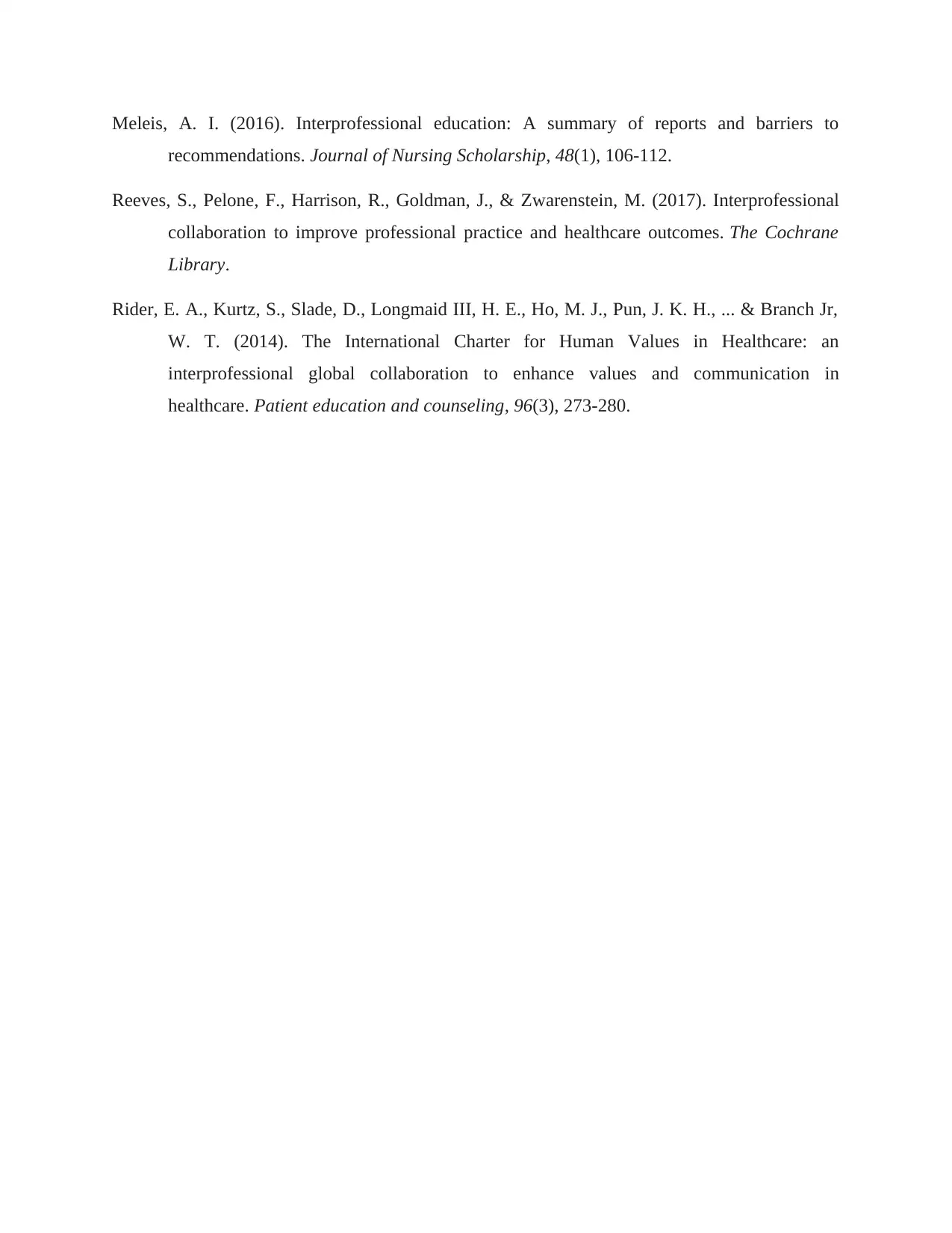
Meleis, A. I. (2016). Interprofessional education: A summary of reports and barriers to
recommendations. Journal of Nursing Scholarship, 48(1), 106-112.
Reeves, S., Pelone, F., Harrison, R., Goldman, J., & Zwarenstein, M. (2017). Interprofessional
collaboration to improve professional practice and healthcare outcomes. The Cochrane
Library.
Rider, E. A., Kurtz, S., Slade, D., Longmaid III, H. E., Ho, M. J., Pun, J. K. H., ... & Branch Jr,
W. T. (2014). The International Charter for Human Values in Healthcare: an
interprofessional global collaboration to enhance values and communication in
healthcare. Patient education and counseling, 96(3), 273-280.
recommendations. Journal of Nursing Scholarship, 48(1), 106-112.
Reeves, S., Pelone, F., Harrison, R., Goldman, J., & Zwarenstein, M. (2017). Interprofessional
collaboration to improve professional practice and healthcare outcomes. The Cochrane
Library.
Rider, E. A., Kurtz, S., Slade, D., Longmaid III, H. E., Ho, M. J., Pun, J. K. H., ... & Branch Jr,
W. T. (2014). The International Charter for Human Values in Healthcare: an
interprofessional global collaboration to enhance values and communication in
healthcare. Patient education and counseling, 96(3), 273-280.
1 out of 7
Related Documents
Your All-in-One AI-Powered Toolkit for Academic Success.
+13062052269
info@desklib.com
Available 24*7 on WhatsApp / Email
![[object Object]](/_next/static/media/star-bottom.7253800d.svg)
Unlock your academic potential
Copyright © 2020–2025 A2Z Services. All Rights Reserved. Developed and managed by ZUCOL.





